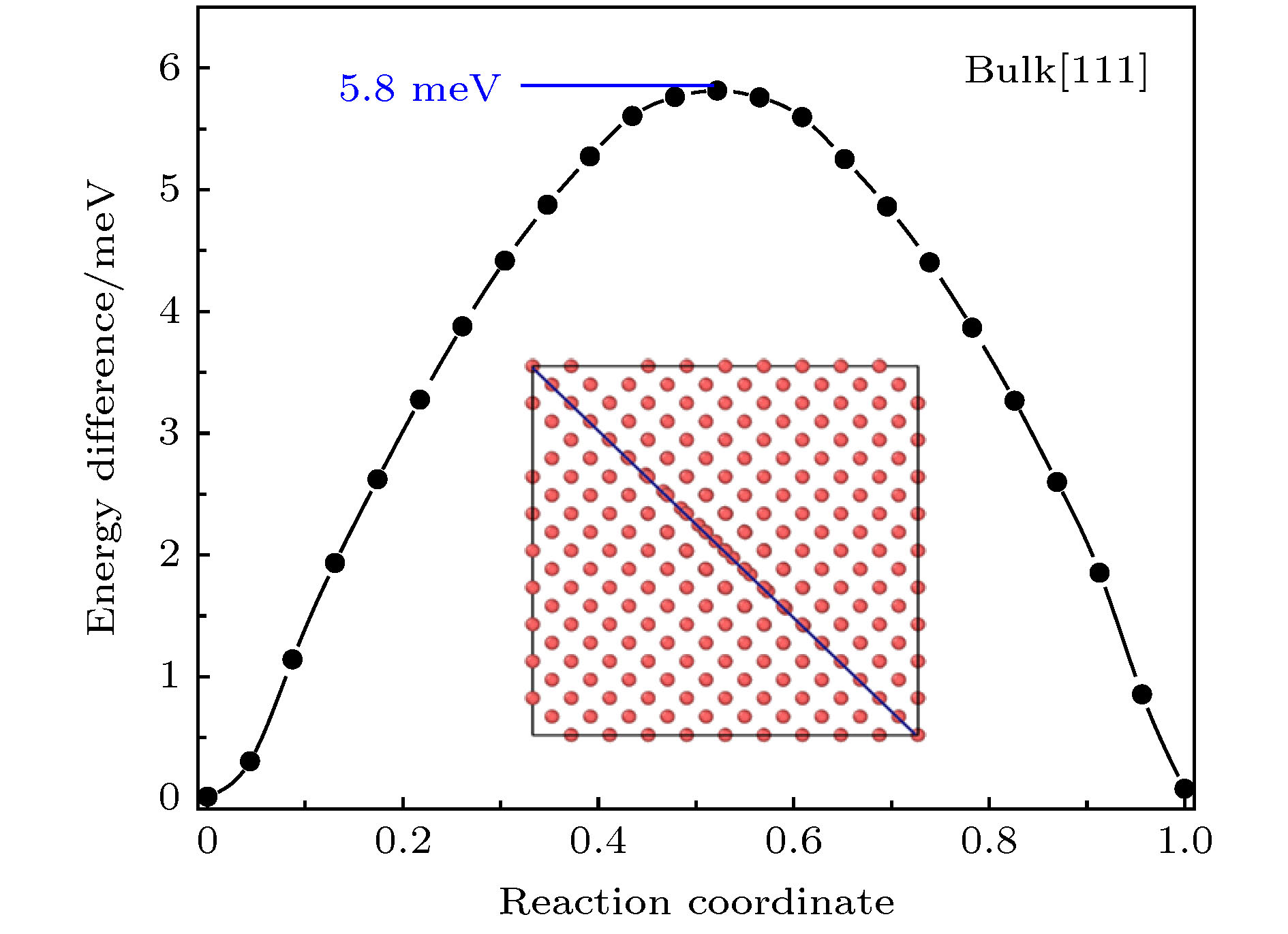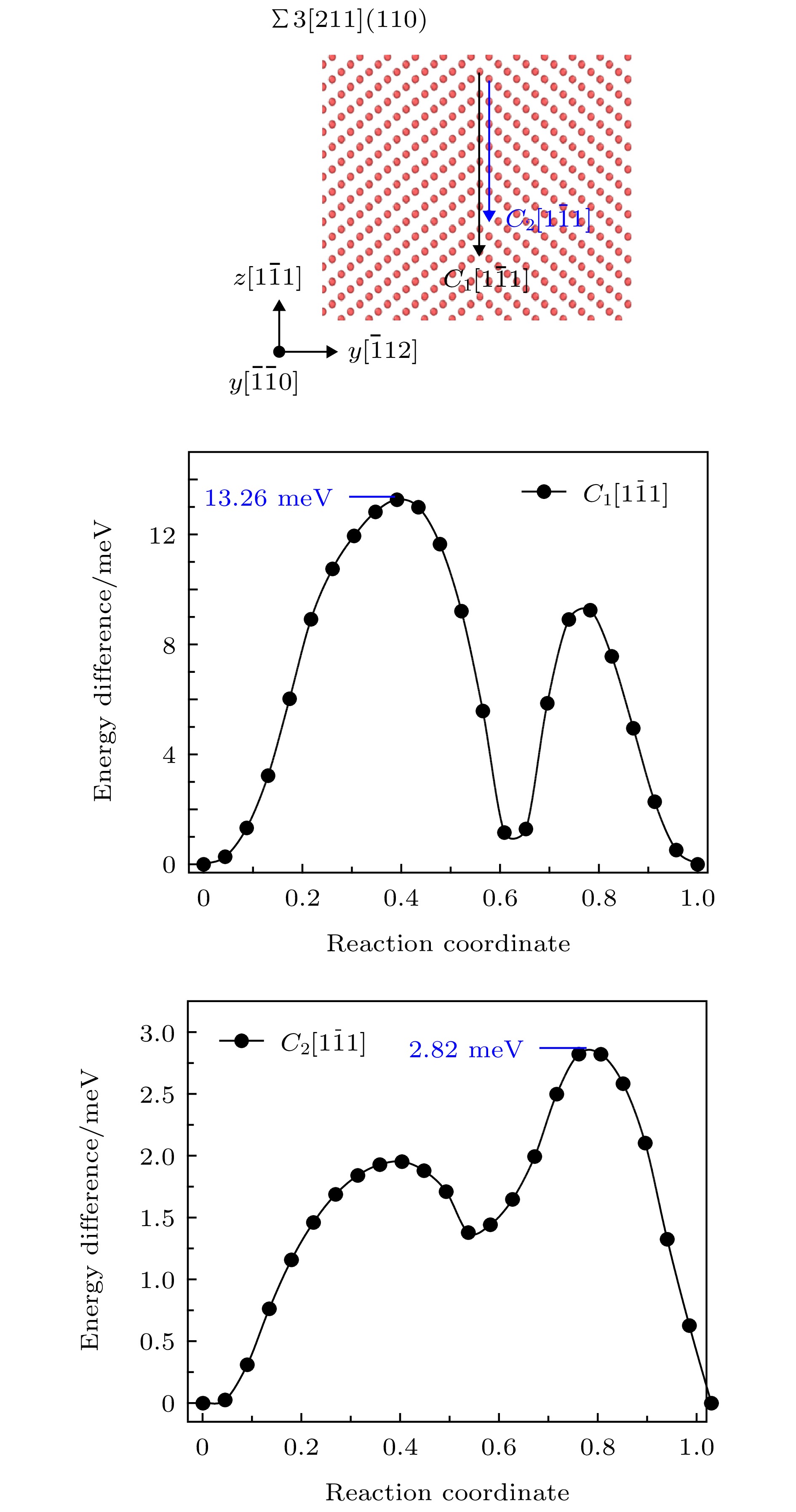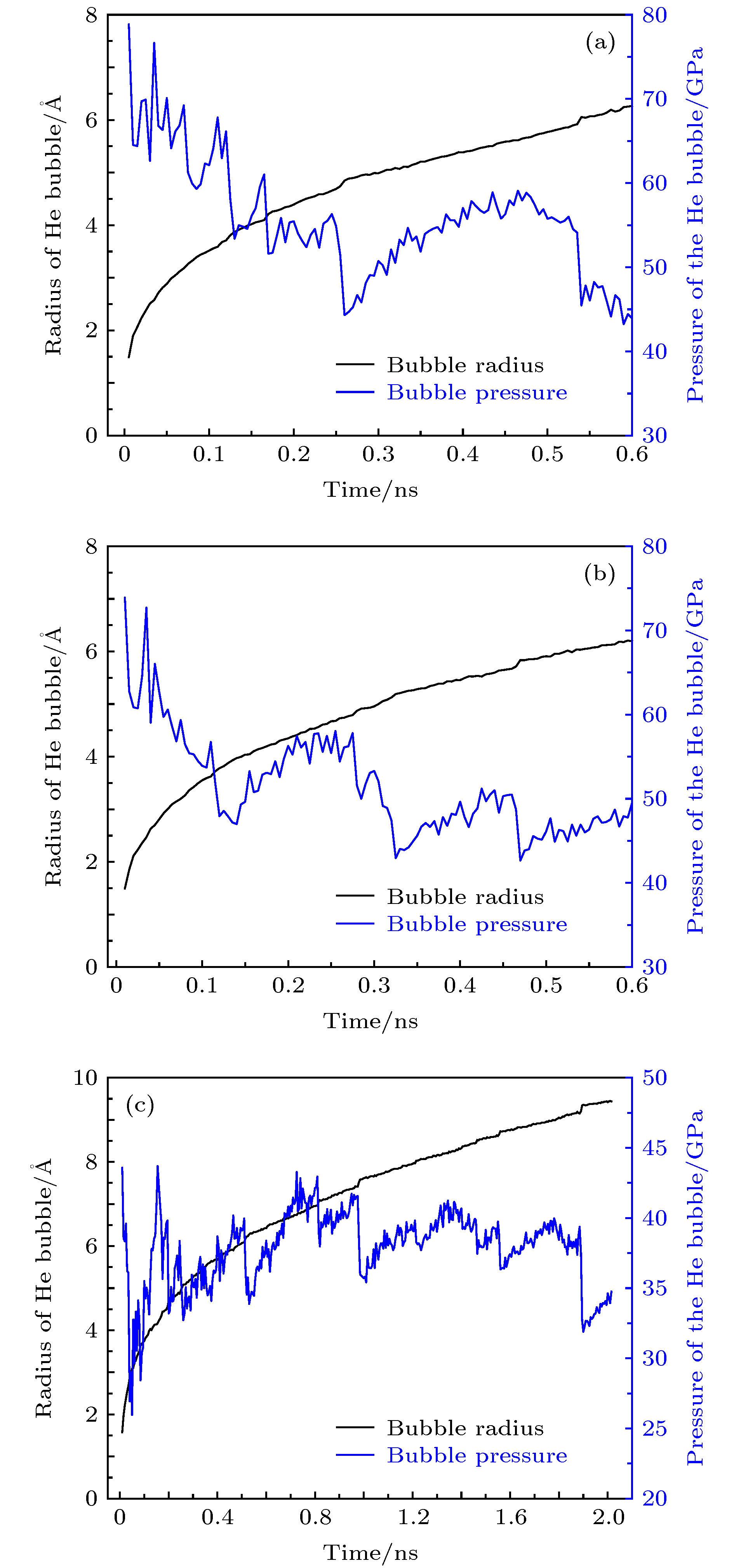-
钨(W)是潜在的聚变堆面向等离子体材料. 聚变反应中产生的氦(He)不溶于金属W, 并在其中易聚集形成He泡, 使W基体发生脆化, 从而导致W基体的性能发生退化. 在前人工作的基础上, 本文采用分子动力学研究了He泡在单晶bcc-W中以及bcc-W中∑3[211](110)和∑9[110](411) 晶界处He泡形核长大初期的演化过程. 结果发现, 晶界处He泡的长大机制和单晶W中有所不同. 单晶W中He泡通过挤出位错环促进长大. 而He泡在∑3[211](110)晶界处的长大机制为: 首先挤出并发射少量自间隙W原子, 而后挤出1/2
$\left\langle {111} \right\rangle $ 位错线, 随后, 该位错线会沿晶界面上[111]方向迁移出去; 在∑9[110](411)晶界处, He泡在我们的模拟时间尺度范围内没有观察到W自间隙子的发射和位错的挤出.Tungsten (W) is a potential candidate for plasma facing materials (PFMs) of fusion reactor. The helium (He) produced in fusion reaction is insoluble and easy to gather and form to He bubbles in W, resulting in embrittlement and degradation of the performance of the W matrix. In this paper, based on molecular dynamics, the nucleation and growth of helium bubbles in the bulk and at ∑3[211](110) and ∑9[110](411) grain boundaries of W was studied. As a result, the growth mechanism of Helium bubbles at grain boundary of W was different from in bulk. Helium bubbles in bulk W grow up by extruding dislocation rings. The growth mechanism of helium bubbles at ∑3[211](110) grain boundary was as follows: Firstly, a small amount of W interstitial atoms were extruded and emitted. And then the 1/2$\left\langle {111} \right\rangle $ dislocation line was extruded. Finally, the 1/2$\left\langle {111} \right\rangle $ dislocation line would migrate along the direction of [111] of the grain boundary interface. Moreover, the emission of W interstitial atoms and dislocation extrusion of the helium bubble were not observed in our simulated time scale at the ∑9[110](411) grain boundary. Then we used the NEB method to calculate the diffusion barrier of self-gap atoms in the bulk and at ∑3[211](110) and ∑9[110](411) grain boundaries of W, which explained the simulation results. The migration energy barrier of W self-gap atoms in the bulk and at ∑3[211](110) grain boundary was only a few to a few millielectron volts. So as long as W self-gap atoms dissociated from the surface of the He bubble in the thermal relaxation process, they can be easily migrated out. However, The migration energy of the W self-gap atom at the ∑9[110](411) grain boundary can be from a few tenths to a few electron volts. Even during the thermal relaxation process, the W self-gap atoms dissociated from the surface of the He bubble. It was difficult for the W self-gap atoms migrated out. Finally, the correlation between He bubble size and stress released was given. Either in bulk or at ∑3[211](110) and ∑9[110](411) grain boundaries of W, after the pressure of the helium bubble becomes stable with time, the radius of the helium bubble would increase rapidly whenever the pressure dropped sharply. So there was a small step on the curve of the evolution of the radius of the helium bubble with time. Thus, helium bubbles in W could promote growth by releasing pressure intermittently.-
Keywords:
- Helium bubbles /
- Tungsten /
- grain boundary /
- molecular dynamics
[1] Pintsuk G 2012 Comprehensive Nuclear Materials (Vol. 5) (Oxford: Elsevier Press) p551
[2] Hirai T, Escourbiac F, Carpentier-Chouchana S, Durocher A, Fedosov A, Ferrand L, Jokinen T, Komarov V, Merola M, Mitteau R, Pitts R A, Shu W, Sugihara M, Barabash V, Kuznetsov V, Riccardi B, Suzuki S 2014 Phys. Scr. T 159 014006
[3] Wei Q, Li N, Sun K, Wang L 2010 Scr. Mater. 63 430
 Google Scholar
Google Scholar
[4] Hetherly J, Martinez E, Di Z, Nastasi M, Caro A 2012 Scr. Mater. 66 17
 Google Scholar
Google Scholar
[5] 郭洪燕, 夏敏, 燕青芝, 郭立平, 陈济红, 葛昌纯 2016 物理学报 65 077803
 Google Scholar
Google Scholar
Guo H Y, Xia M, Yan Q Z, Guo L P, Ge C C 2016 Acta Phys. Sin. 65 077803
 Google Scholar
Google Scholar
[6] Wang J, Gao X, Gao N, Wang Z G, Cui M, Wei K, Yao C, Sun J, Li B, Zhu Y, Pang L, Li Y, Wang D, Xie E 2015 J. Nucl. Mater. 457 182
 Google Scholar
Google Scholar
[7] Ding M S, Du J P, Wan L, Ogata S, Tian L, EvanMa, Han W Z, Li J, Shan Z W 2016 Nano. Lett. 16 4118
 Google Scholar
Google Scholar
[8] 马玉田, 刘俊标, 韩立, 田利丰, 王学聪, 孟祥敏, 肖善曲, 王波 2016 物理学报 68 040702
Ma Y T, Liu J B, Han L, Tian L F, Wang X C, Meng X M, Xiao S Q, Wang B 2016 Acta Phys. Sin. 68 040702
[9] 王欣欣, 张颖, 周洪波, 王金龙 2014 物理学报 63 046103
 Google Scholar
Google Scholar
Wang X X, Zhang Y, Zhou H B, Wang J L 2014 Acta Phys. Sin. 63 046103
 Google Scholar
Google Scholar
[10] El-Atwani O, Gonderman S, Suslov S, Efe M, Temmerman G D, Morgan T, Bystrov K, Hattar K, Allain J P 2015 Fusion Eng. Des. 93 9
 Google Scholar
Google Scholar
[11] Miyamoto M, Mikami S, Nagashima H, Iijima N, Nishijima D, Doerner R P, Yoshida N, Watanabe H, Ueda Y, Sagara A 2015 J. Nucl. Mater. 463 333
 Google Scholar
Google Scholar
[12] Wang J, Niu L-L, Shu X, Zhang Y 2015 Nucl. Fusion 55 092003
 Google Scholar
Google Scholar
[13] Kobayashi R, Hattori T, Tamura T, Ogata S 2015 J. Nucl. Mater. 463 1071
 Google Scholar
Google Scholar
[14] Sandoval L, Perez D, Uberuaga B P, Voter A F 2015 Phys. Rev. Lett. 114 105502
 Google Scholar
Google Scholar
[15] Yang S T, Hu N W, Gou X Q, Wang C L, Zhu X L 2016 RCS Advances 64 59875
[16] Yang L, Deng H Q, Gao F, Heinisch H L, Kurtz R J, Hu S Y, Li Y L, Zu X T 2013 Nucl. Instrum. Methods B 303 68
 Google Scholar
Google Scholar
[17] Xie H X, Gao N, Xu K, Lu G H, Yue T, Yin F X 2017 Acta Mater. 141 10
 Google Scholar
Google Scholar
[18] Liu X Y, Uberuaga B P, Perez D, Voter A F 2018 Mater. Res. Lett. 9 522
[19] Yang L, Gao F, Kurtz R J, Zu X T, Peng S M, Long X G, Zhou X S 2015 Acta Mater. 97 86
 Google Scholar
Google Scholar
[20] Zhao Q, Zhang Z, Li Y, Ouyang X 2017 Sci. Technol. Nucl. Ins. 2017 1
[21] Plimpton S 1995 J. Comput. Phys. 117 1
 Google Scholar
Google Scholar
[22] Stukowski A 2010 Modell. Simul. Mater. Sci. Eng. 18 015012
 Google Scholar
Google Scholar
[23] Ackland G J, Thetford R 1987 Philos. Mag. A 56 15
[24] Beck D E 1968 Mol. Phys. 14 311
 Google Scholar
Google Scholar
[25] Juslin N, Wirth B D 2013 J. Nucl. Mater. 432 61
 Google Scholar
Google Scholar
[26] Ziegler J F, Biersack J P, Littmark U 1985 The Stopping and Range of Ions in Matter (Vol. 1) (New York: Pergamon Press) p93
[27] Stukowski A, Albe K 2010 Modell. Simul. Mater. Sci. Eng. 18 085001
 Google Scholar
Google Scholar
[28] Guo S H, Zhu B E, Liu W C, Pan Z Y, Wang Y X 2009 Nucl. Instrum. Methods B 267 3278
 Google Scholar
Google Scholar
[29] Yang L, Zu Z Q, Peng S M, Long X G, Zhou X S, Zu X T, Heinisch H L, Kurtz R J, Gao F 2013 J. Nucl. Mater. 441 6
 Google Scholar
Google Scholar
[30] Rycroft C H, Grest G S, Landry J W, Bazant M Z 2006 Phys. Rev. E 74 021306
 Google Scholar
Google Scholar
[31] Chen L, Liu Y L, Zhou H B, Jin S, Zhang Y, Lu G H 2012 Sci. Chin. Phys. Mech. 55 614
 Google Scholar
Google Scholar
[32] He W H, Gao X, Gao N, Wang J, Wang D, Cui M H, Pang L L, Wang Z G 2018 Chin. Phys. Lett. 35 49
[33] Banisalman M J, Oda T 2019 Comput. Mater. Sci. 158 346
 Google Scholar
Google Scholar
-
图 2 氦泡在W中∑3[211](110)晶界处的成核长大过程 (a) 0.043 ns, 8 He, 1 SIA; (b) 0.120 ns, 24 He, 6 SIAs; (c) 0.125 ns, 24 He, 6 SIAs; (d) 0.466 ns, 93 He, 21 SIAs; (e) 0.469 ns, 94 He, 22 SIAs; (f) 0.470 ns, 94 He, 22 SIAs
Fig. 2. The nucleation and growth of helium clusters at grain boundary ∑3[211](110) in W: (a) 0.043 ns, 8 He, 1 SIA; (b) 0.120 ns, 24 He, 6 SIAs; (c) 0.125 ns, 24 He, 6 SIAs; (d) 0.466 ns, 93 He, 21 SIAs; (e) 0.469 ns, 94 He, 22 SIAs; (f) 0.470 ns, 94 He, 22 SIAs
图 3 氦泡在W中∑9[110](411)晶界处的成核长大过程 (a) 0.02 ns, 3 He, 1 SIA; (b) 0.1 ns, 19 He, 7 SIAs; (c) 0.5 ns, 99 He, 23 SIAs; (d) 1 ns, 199 He, 44 SIAs; (e) 2 ns, 399 He, 121 SIAs; (f) 2 ns
Fig. 3. The nucleation and growth of helium clusters at grain boundary ∑9[110](411) in W: (a) 0.02 ns, 3 He, 1 SIA; (b) 0.1 ns, 19 He, 7 SIAs; (c) 0.5 ns, 99 He, 23 SIAs; (d) 1 ns, 199 He, 44 SIAs; (e) 2 ns, 399 He, 121 SIAs; (f) 2 ns
图 7 (a)单晶W中氦泡的压强与半径随时间的变化; (b) ∑3[211](110)晶界处氦泡的压强与半径随时间的变化; (c) ∑9[110](411)晶界处氦泡的压强与半径随时间的变化
Fig. 7. (a) The radius and pressure of the He bubble as a function of simulation time in bulk W; (b) the radius and pressure of the He bubble as a function of simulation time at at grain boundary ∑3[211](110); (c) the radius and pressure of the He bubble as a function of simulation time at at grain boundary ∑9[110](411)
表 1 单晶W及晶界处弗伦克尔缺陷对的形成能
Table 1. Formation energy of frenkel defect pair in bulk W and at grain boundaries.
缺陷位置 弗伦克尔缺陷对的形成能/eV 单晶W中 14.10 ∑3[211](110)晶界处 12.73 ∑9[110](411)晶界处 3.84 -
[1] Pintsuk G 2012 Comprehensive Nuclear Materials (Vol. 5) (Oxford: Elsevier Press) p551
[2] Hirai T, Escourbiac F, Carpentier-Chouchana S, Durocher A, Fedosov A, Ferrand L, Jokinen T, Komarov V, Merola M, Mitteau R, Pitts R A, Shu W, Sugihara M, Barabash V, Kuznetsov V, Riccardi B, Suzuki S 2014 Phys. Scr. T 159 014006
[3] Wei Q, Li N, Sun K, Wang L 2010 Scr. Mater. 63 430
 Google Scholar
Google Scholar
[4] Hetherly J, Martinez E, Di Z, Nastasi M, Caro A 2012 Scr. Mater. 66 17
 Google Scholar
Google Scholar
[5] 郭洪燕, 夏敏, 燕青芝, 郭立平, 陈济红, 葛昌纯 2016 物理学报 65 077803
 Google Scholar
Google Scholar
Guo H Y, Xia M, Yan Q Z, Guo L P, Ge C C 2016 Acta Phys. Sin. 65 077803
 Google Scholar
Google Scholar
[6] Wang J, Gao X, Gao N, Wang Z G, Cui M, Wei K, Yao C, Sun J, Li B, Zhu Y, Pang L, Li Y, Wang D, Xie E 2015 J. Nucl. Mater. 457 182
 Google Scholar
Google Scholar
[7] Ding M S, Du J P, Wan L, Ogata S, Tian L, EvanMa, Han W Z, Li J, Shan Z W 2016 Nano. Lett. 16 4118
 Google Scholar
Google Scholar
[8] 马玉田, 刘俊标, 韩立, 田利丰, 王学聪, 孟祥敏, 肖善曲, 王波 2016 物理学报 68 040702
Ma Y T, Liu J B, Han L, Tian L F, Wang X C, Meng X M, Xiao S Q, Wang B 2016 Acta Phys. Sin. 68 040702
[9] 王欣欣, 张颖, 周洪波, 王金龙 2014 物理学报 63 046103
 Google Scholar
Google Scholar
Wang X X, Zhang Y, Zhou H B, Wang J L 2014 Acta Phys. Sin. 63 046103
 Google Scholar
Google Scholar
[10] El-Atwani O, Gonderman S, Suslov S, Efe M, Temmerman G D, Morgan T, Bystrov K, Hattar K, Allain J P 2015 Fusion Eng. Des. 93 9
 Google Scholar
Google Scholar
[11] Miyamoto M, Mikami S, Nagashima H, Iijima N, Nishijima D, Doerner R P, Yoshida N, Watanabe H, Ueda Y, Sagara A 2015 J. Nucl. Mater. 463 333
 Google Scholar
Google Scholar
[12] Wang J, Niu L-L, Shu X, Zhang Y 2015 Nucl. Fusion 55 092003
 Google Scholar
Google Scholar
[13] Kobayashi R, Hattori T, Tamura T, Ogata S 2015 J. Nucl. Mater. 463 1071
 Google Scholar
Google Scholar
[14] Sandoval L, Perez D, Uberuaga B P, Voter A F 2015 Phys. Rev. Lett. 114 105502
 Google Scholar
Google Scholar
[15] Yang S T, Hu N W, Gou X Q, Wang C L, Zhu X L 2016 RCS Advances 64 59875
[16] Yang L, Deng H Q, Gao F, Heinisch H L, Kurtz R J, Hu S Y, Li Y L, Zu X T 2013 Nucl. Instrum. Methods B 303 68
 Google Scholar
Google Scholar
[17] Xie H X, Gao N, Xu K, Lu G H, Yue T, Yin F X 2017 Acta Mater. 141 10
 Google Scholar
Google Scholar
[18] Liu X Y, Uberuaga B P, Perez D, Voter A F 2018 Mater. Res. Lett. 9 522
[19] Yang L, Gao F, Kurtz R J, Zu X T, Peng S M, Long X G, Zhou X S 2015 Acta Mater. 97 86
 Google Scholar
Google Scholar
[20] Zhao Q, Zhang Z, Li Y, Ouyang X 2017 Sci. Technol. Nucl. Ins. 2017 1
[21] Plimpton S 1995 J. Comput. Phys. 117 1
 Google Scholar
Google Scholar
[22] Stukowski A 2010 Modell. Simul. Mater. Sci. Eng. 18 015012
 Google Scholar
Google Scholar
[23] Ackland G J, Thetford R 1987 Philos. Mag. A 56 15
[24] Beck D E 1968 Mol. Phys. 14 311
 Google Scholar
Google Scholar
[25] Juslin N, Wirth B D 2013 J. Nucl. Mater. 432 61
 Google Scholar
Google Scholar
[26] Ziegler J F, Biersack J P, Littmark U 1985 The Stopping and Range of Ions in Matter (Vol. 1) (New York: Pergamon Press) p93
[27] Stukowski A, Albe K 2010 Modell. Simul. Mater. Sci. Eng. 18 085001
 Google Scholar
Google Scholar
[28] Guo S H, Zhu B E, Liu W C, Pan Z Y, Wang Y X 2009 Nucl. Instrum. Methods B 267 3278
 Google Scholar
Google Scholar
[29] Yang L, Zu Z Q, Peng S M, Long X G, Zhou X S, Zu X T, Heinisch H L, Kurtz R J, Gao F 2013 J. Nucl. Mater. 441 6
 Google Scholar
Google Scholar
[30] Rycroft C H, Grest G S, Landry J W, Bazant M Z 2006 Phys. Rev. E 74 021306
 Google Scholar
Google Scholar
[31] Chen L, Liu Y L, Zhou H B, Jin S, Zhang Y, Lu G H 2012 Sci. Chin. Phys. Mech. 55 614
 Google Scholar
Google Scholar
[32] He W H, Gao X, Gao N, Wang J, Wang D, Cui M H, Pang L L, Wang Z G 2018 Chin. Phys. Lett. 35 49
[33] Banisalman M J, Oda T 2019 Comput. Mater. Sci. 158 346
 Google Scholar
Google Scholar
计量
- 文章访问数: 15840
- PDF下载量: 226
- 被引次数: 0
















 下载:
下载:






